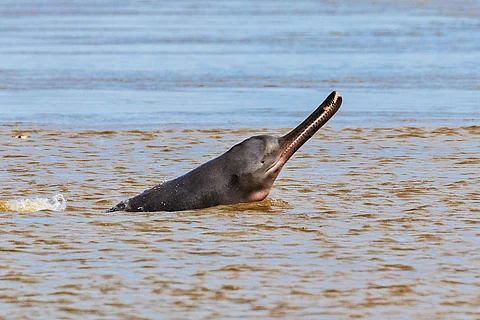

In the quiet shimmer of the Ganga at dawn, a curved fin slices through the water—brief, breathless, and gone in a heartbeat. It is one of countless Ganges River Dolphins that now navigate the basin’s winding waters—a presence that speaks not just of endurance, but of a quiet, determined return. These silent swimmers, long regarded as symbols of a thriving river ecosystem, were seen across both the main stretch and its tributaries—reclaiming the waters that have always been their home.
But this resurgence is hard-won. Not long ago, the future of the Ganges River Dolphin teetered on the edge. Their numbers had plummeted under the weight of human ambition—fragmented by dams and barrages, starved by vanishing fish stocks, and silenced by the constant churn of vessel propellers. Entire stretches of their ancestral habitat had been altered or lost to dredging, canalisation, and unsustainable water diversion. Each echoing engine and gill net in the water became a new threat.
Today, the Ganges River Dolphin glides once more through the waters of its ancestral home. Its return is not merely a biological triumph but a testament to human will and purpose, shaped by one of India’s most ambitious environmental efforts: the Namami Gange mission.
Launched in 2014 as the Government of India’s flagship initiative for river rejuvenation, Namami Gange took on an immense responsibility—to cleanse, restore, and safeguard the Ganga and its sprawling network of tributaries. Spanning 11 states and touching the lives of more than 500 million people, the Ganga basin is not only the country’s most vital ecological artery but also its spiritual soul. This sacred river bore the weight of unchecked urbanisation, untreated sewage, and industrial waste for decades. It gasped for reprieve. The near-vanishing of the dolphin, a keystone species, was perhaps its most eloquent and tragic plea.
But the current is shifting. The river breathes easier now, and with every fresh ripple, hope returns.
The Ganges River Dolphin, officially declared India’s National Aquatic Animal in 2009, is more than just a species under threat. It is an ecological barometer. Sensitive to noise, chemical pollutants, and reduced oxygen levels, dolphins require clean water and abundant fish populations to survive.
Their reappearance in the Ganga—particularly the sightings of juvenile dolphins—is among the clearest signs of a river in recovery. In Narora, a vital Ramsar site in Uttar Pradesh, the 165-kilometre stretch between Brijghat and Narora offers a crucial habitat for the Gangetic dolphin.
Further downstream, the Vikramshila Gangetic Dolphin Sanctuary in Bihar’s Bhagalpur district—a 60-kilometre protected stretch between Sultanganj and Kahalgaon—has long served as a stronghold for these endangered creatures, sheltering a rich diversity of aquatic life since its designation in 1991. Even in parts of West Bengal, long-silent stretches of the Ganga now echo with ripples and surfacing fins. The appearance of dolphin calves across these regions is more than a hopeful sign—it’s living proof that the river is beginning to heal.
So, what changed? The Namami Gange mission adopted a holistic and science-driven approach to river restoration. Over 400 projects have been launched under its banner, focusing on sewage treatment, solid waste management, riverfront development, and biodiversity conservation.
A significant thrust was placed on intercepting and treating wastewater before it could enter the river. Massive investments in sewage treatment plants (STPs)—such as those in Kanpur, Patna, and Haridwar—have significantly reduced the toxic load entering the Ganga. In cities like Varanasi, treated water now meets standards that are safe enough to support aquatic life.
Simultaneously, ecological interventions were rolled out to protect and revive native species. The Ganga River Dolphin Conservation Plan, supported by the WII and NMCG, identified critical dolphin habitats, mapped threats, and trained local volunteers to monitor and protect the species.
Fisherfolk were encouraged to adopt dolphin-friendly practices. Awareness campaigns in schools and riverside communities fostered pride in the river and its unique biodiversity.
What makes the story of the dolphin even more compelling is its human connection. The Ganga is not just a body of water but a cultural, spiritual, and economic lifeline. From ritual baths to agriculture, folklore to festivals, the river shapes everyday life in North India.
In recent years, Namami Gange has worked to turn these connections into conservation partnerships. Eco-sensitive tourism initiatives—such as guided dolphin safaris in Bhagalpur and awareness walks in Haridwar—are helping communities become stakeholders in the river’s well-being. In many areas, local women have been trained as “Ganga Praharis” or river warriors, tasked with spreading knowledge and vigilance around pollution and poaching.
The return of the river dolphin is a conservation win, but it’s also a reminder that environmental recoveries take time, trust, and tenacity. Challenges remain, but the foundation has been laid, the data is encouraging, and the dolphins are back.
In 2023, India celebrated the Ganga Utsav with the theme “River Rejuvenation through Public Participation.” Nowhere is that spirit more vividly on display than a dolphin's leap across the waters it once abandoned.
The Ganges River Dolphin is blind and uses echolocation to navigate and hunt.
It can live only in freshwater and is one of the few river dolphins left worldwide.
The IUCN has declared its protection a national priority as an endangered species.
Vikramshila Gangetic Dolphin Sanctuary in Bihar is India’s only protected area for river dolphins.
